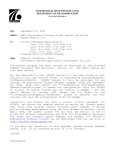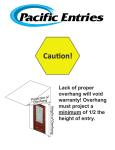Download 014 - PENNDOT LRFD and Engineering Programs
Transcript
PennDOT e-Notification Bureau of Business Solutions and Services Highway/Engineering Applications Division PSLRFD No. 014 July 17, 2014 Release of Version 2.8.0.0 The Department’s LRFD Prestressed Concrete Girder Design and Rating (PSLRFD) program has been revised as described in the attached “Summary of May 2014 Revisions – Version 2.8.0.0”. The new program has been placed on PennDOT servers for use by the Districts. Consultants and others, who have a current license agreement for PSLRFD Version 2.7.0.0, can obtain the updated version by submitting an Update Request form along with the update fee of $500 for private organizations and $50 for governmental agencies. Updates for PSLRFD Version 2.6.0.0 or earlier will require an additional fee. For PSLRFD update fee details, refer to the following link: http://penndot.engrprograms.com/home/Ordering/PSLRFD.htm. The update fee is waived for federal and state transportation agencies. The Software Update Request form can be obtained on the PennDOT Engineering Software Support website at http://penndot.engrprograms.com by clicking on “Ordering/Updating” and, then on “Update Form”. NOTE: PSLRFD v2.8.0.0 is not compatible with Windows XP. Please note that the software will no longer be provided on a CD. Once payment is received, an e-mail will be sent with download instructions. The new installation will require a License Key that will be provided in the email. A valid e-mail address must be provided on the Update Form in order to receive the download instructions. Please direct any questions concerning the above to: Robert F. Yashinsky, P.E. PennDOT Bureau of Business Solutions and Services Highway/Engineering Applications Division Phone: (717) 787-8407 | Fax: (717) 705-5529 e-mail: [email protected] Attachment Archived copies of all previously distributed e-Notifications can be obtained from the PennDOT LRFD and Engineering Programs website at http://penndot.engrprograms.com/home and clicking on "e-Notification" and then "Mailing List Archives." SUMMARY OF MAY 2014 REVISIONS - VERSION 2.8.0.0 Since the release of PSLRFD Version 2.7.0.0 several revision requests and user requested enhancements have been received. This release of PSLRFD Version 2.8.0.0 contains the following revisions and enhancements. Programming Revisions 1. The method of calling the engineering program DLL from the Engineering Assistant has been changed for compatibility with EngAsst v2.5.0.0 which uses Microsoft’s .NET Framework, version 4.5. Because of this, PSLRFD will no longer work with EngAsst v2.4.0.6 or v2.4.0.9 unless the EngAsst “Edit / Run EXE - Command Window” option is selected. PSLRFD will no longer work with EngAsst v2.4.0.0 and earlier. (Request 544) 2. The program is now compiled with Intel Visual Fortran Composer XE version 2011.9.300 using Visual Studio 2010. (Request 503) Input Revisions 3. When individual dimensions are entered using the BDM command, dimension compatibility requirements are now checked and any violations result in an error message. (Request 436) 4. An input check for the total number of debonded strands being greater than the total number of strands is now performed for straight or draped strands with crack control debonding. Prior to this change multiple warning messages were printed during the shear design and/or analysis when the total crack control debonded strands exceeded the total strands. (Request 498) th 5. The DES command now allows the 9 parameter, Bottom Flange Thickness, to be defaulted (comma specified after the previous parameter in the input file) on the command line for non-Bulb-Tee beam th shapes. Previously, the user manual indicated the 9 parameter should be left blank for all non-Bulb-Tee th beam types but manually adding a comma after the 8 parameter in the input file would result in an error. (Request 511) 6. The skew angle limitations for beams entered on the BDM command are now being correctly set. (Request 532) Output Revisions 7. The reaction and rotation distribution factor output table now reports the same flags (indicating the number of lanes loaded and any range of applicability warnings) as the moment and shear distribution factors. (Request 442) 8. The Horizontal Shear output report is no longer processed for non-composite beams during the rating vehicle specification checking. Previously, the reports were processed for non-composite beams and reported in the summary table to have specification check errors, but the reports could not be requested to print. (Request 462) 9. The ratings note in the Detailers Summary output now states that future wearing surface is included in the ratings, or excluded in the ratings base on the presence of the FWS loading entered by the user. Previously, the note always stated that future wearing surface was including in the rating even when a FWS loading was not entered. (Request 507) 10. A new output table named “EFFECTIVE C.G.S. AND NUMBER OF STRANDS” was added to the program to report the effective center of gravity of the strand pattern and the effective number of strands along each span. This new table includes partially effective strands that occur when a new cutoff location occurs within a transfer length region for strands that were previously cutoff. (Request 513) 11. The design of a non-composite adjacent box beam now produces a CBE message and references SOL 431-06-01. (Request 519) 12. The strand output tables now provide a consistent output format for Straight Strands, Draped Strands, Debonded Strands or Debonded / Draped Strands. (Request 534) 13. The Rating Summary output for the Detailer Summary Report now displays the correct Limit State for the PHL-93 Operating rating when Strength IA controls the rating. Previously, the Strength II Limit State was being reported when the Strength IA Limit State controlled. (Request 547) Documentation Revisions 14. The User Manual and Engineering Assistant help now indicate the cutoff points for the longitudinal slab reinforcement entered on the SST command are the physical cutoff locations and the development length is calculated by the program. (Request 509) 15. PennDOT has discontinued support for Windows XP and references to Windows XP have been removed from the User Manual. (Request 546) Ratings Revisions 16. A new input item on the ORF command now allows ratings to be generated both with and without the Future Wearing Surface (FWS) load in a single analysis run. Previously, the user had to make two separate analysis runs to obtain both sets of ratings. (Request 441) Distribution Factor Revisions 17. The fatigue distribution factor calculations for non-composite adjacent beams now set the number of design lanes to the number of design lanes entered on the CDF command. Previously, the number of design lanes was being set to one for the fatigue distribution factor calculations. Also, the C equation is limited to be less than or equal to K per a proposed DM-4 revision. The User Manual now documents the distribution factor equations used by the program for composite and non-composite adjacent beams. (Request 483) Continuous Beam Analysis Revisions 18. When locating vehicle axles at the maximum shear influence line ordinates, tolerances are now avoided by setting the axle location exactly equal to the corresponding shear influence line abscissa. Previously, for certain bridge geometry conditions a tolerance issue could result is slightly unsymmetrical CBA shear results for a symmetrical bridge. (Request 457) 19. The Department’s Continuous Beam Analysis program, CBA Version 3.6.0.5, has been incorporated into the program. (Request 494) Live Load Rotation Revisions 20. The total positive live load rotation is now correctly considered when determining the controlling value for live load rotation. The moment distribution factors are now applied at the left side of the support when factoring live load rotations. Previously, a symmetrical bridge would have unsymmetrical total positive live load rotations. (Request 458) Specification Revisions 21. DM-4 Section 9.7.1.5.1P, Overhang of Deck Slab on Concrete and Steel Girder Bridges is now being considered for analysis and design runs. For analysis runs a Chief Bridge Engineer warning message is given when the beam depth violates the overhang limit and the run continues. For design runs, by default, beams that violate the overhang limit will not be considered. For designs runs, if a specific beam is specified to be designed, an error message is given when the beam depth violates the overhang limit and the program stops. A new input item, Overhang to Beam Depth Override, on the CTL command can be set to ‘Y’ to allow the program to consider designing beams that violate the overhang limit. If the design run is successful, a Chief Bridge Engineer warning message is given even when the override parameter is set to ‘Y’. (Request 487/501) Shear Revisions 22. For shear analysis runs, stirrup change locations are now added as analysis points and reported in shear related output tables. Previously, stirrup change locations did not appear in the shear related output table th unless they occurred at a 20 point. (Request 499) 23. A consistent tolerance is now used when computing the d(critical) location for shear in design and analysis runs. Previously, a different tolerance was used for design and analysis which resulted in different d(critical) locations. The different d(critical) locations could result in analysis runs, based on the design run, having shear ratings less than 1.0. (Request 538) Debonding Revisions 24. A tolerance is now considered when comparing the first debonding cutoff location to debonding constant DB10, minimum recommended debonded cutoff length from centerline of bearing (6 inches for I-beams, bulb-tee beams and Type F NEXT beams; 30 inches for box beams). Previously, certain input files with f’c optimization could result in an endless loop. (Request 491) Computed Loads Revisions 25. The calculation of exterior diaphragm loads now accounts for the skew angle in accordance with BD653M. Intermediate exterior diaphragms are placed along the skew when the skew angle is between 90 and 75 degrees. End diaphragms are always placed along the skew. (Request 517) Strand Pattern Revisions 26. The post-tensioning duct in adjacent box beams and adjacent plank beams is now located at the beam mid-depth per Sheet 2 of BC-775M (Change 2). The standard strand patterns have been revised to avoid interference between the post-tensioning duct pocket and prestressing strands. Two commands, Tendon Location (TND) and Strand Configuration at Beam End (SCE), now define the strand and tendon geometry to allow the program to check for interference. (Request 534)









